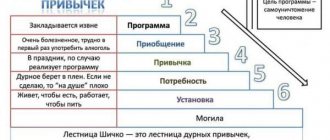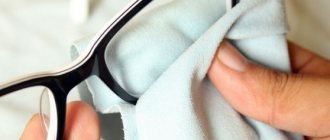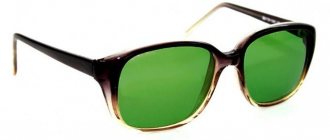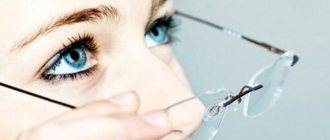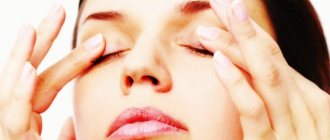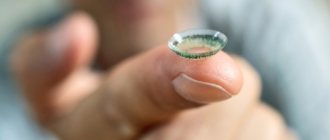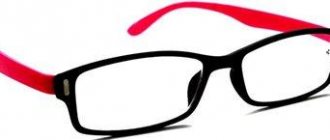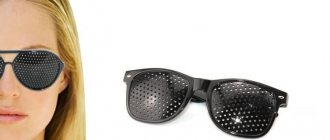Professor Pankov's glasses - instructions for use
Pankov glasses are a compact device designed for quantum restoration and iridoreflexotherapy, as well as timely prevention of diseases of the eyes and internal organs.
The device was created by prof. Oleg Pankov is still used today in specialized clinics, ophthalmology departments of hospitals, as well as in outpatient and home settings for the rehabilitation and prevention of diseases of the organ of vision. “Pankov glasses” are recommended for those whose work causes high visual stress (office workers, researchers, managers, teachers, drivers, pilots, programmers, writers, etc.)
The device is also needed by older people whose vision is subject to age-related changes (such as cataracts, glaucoma or retinal angiopathy, including those caused by high blood pressure or diabetes) and children whose eyes are vulnerable due to growth patterns.
Recommendations for the use of training glasses
Ophthalmologists prescribe the device to the following categories of patients:
- For those who experience severe stress on their vision throughout the day. Most often this is associated with professional activities, for example, seamstresses or writers;
- Elderly people suffering from degenerative eye changes (cataracts, glaucoma);
- During the period of increased growth of children, when the visual apparatus is not strong and is easily influenced by any negative factor.
The simulator is also prescribed for diagnosing diseases such as:
- Strabismus;
- Lazy eye syndrome;
- Astigmatism;
- Myopia or farsightedness;
- Retinal dystrophy;
- Amblyopia;
- Dry eye syndrome.
| Before using the device, be sure to consult an ophthalmologist! |
Return to contents
Specifications
The “Pankov Glasses” device is a spectacle frame in which LED emitters are mounted, controlled by built-in microprocessor controllers, which are located directly in the emitters. These emitters are combined with power supplies.
Radiation wavelengths are 450 nm, 530 nm and 650 nm. Number of light emitters – 2 pcs. The operating mode of outgoing radiation is pulse-periodic. Power consumption - no more than 0.1 W. Power supply – 4 button batteries type AG-13. The weight of the device is 200 g.
The set “Pankov’s Glasses” includes: 1. LED ophthalmic device “Pankov’s Glasses” - 1 pc. 2. Technical passport – 1 pc. 3. Packing box – 1 pc.
How do Sidorenko glasses work?
Sidorenko's glasses are also an ophthalmological device that has a health-prophylactic nature . In addition to restoring visual processes, they have a strengthening effect on the eyelids and the area around the eyes. That is, there is also a cosmetic effect.
Sidorenko's apparatus looks like goggles that protect swimmers' eyes. But instead of ordinary glass, it is equipped with miniature pressure chambers. When put on, they come close to the eyes. The basis of the therapeutic effect of Sidorenko glasses is the positive effect of low-intensity vacuum pressure on the eye muscle. This device also eliminates the destruction of eye cells by free radicals.
In addition, Sidorenko’s device has the same emitters built into it as Pankov’s glasses, six in number, but slightly improved. The emitters are powered by button-type batteries. There is also a timer. The device weighs 700 grams .
The effect, as in the case of Pankov glasses, is achieved by improving the process of enriching the eye structures with nutrients due to accelerated metabolism and improved blood circulation.
Operating principle of the device
Pulses of light, affecting the organ of vision, can have a unique healing effect. They force the pupils to reflexively constrict and then dilate, which helps relieve spasms, increase the strength of the accommodative muscle, which is responsible for focusing images on the retina, by changing the shape of the lens. Rhythmic contractions of the muscles of the internal media of the eye, provoked by the light exposure of the device, increase blood circulation in the organ of vision, activate lymphatic drainage, improve microcirculation in the retina and other tissues of the eye, improve their nutrition, activate the mechanisms of neural transmission, as well as visual perception.
The portable device transforms the diameter of the pupil, changing the position of the iris, resulting in improved outflow of intraocular fluid into the anterior chamber, where it enriches the tissues lying inside with nutrients and oxygen. As a result, the nutrition of the anterior segment of the eyes, including the cornea, iris, and lens, improves. Such useful properties of the Pankov Glasses apparatus allow us to recommend them for use in diseases of these eye structures.
Quantum energy therapy
The eye is an organ created to perceive light. That is why light as a healing agent has a powerful effect. From a scientific perspective, light is a stream of electromagnetic energy with different wavelengths emitted by the Sun. When waves reflected from objects hit the retina, they create the sensation of light.
We see using reflected light. In the visible range, low-frequency electromagnetic waves are registered by the brain as red, and high-frequency waves as violet. Due to the molecular structure and pigmentation of each object, rays are mixed, absorbed, and reflected at different intensities. Objects that appear dark absorb more light and therefore reflect less. Accordingly, the light flux that enters the eye is reduced, which creates the illusion of a darker color. Lighter objects reflect more light, creating the illusion of shine and brightness.
If we split light into separate components with different wavelengths, we get different colors. The seven colors of the rainbow are only a small part of the spectrum of sunlight. Each color has many shades. Each object has its own absorption and reflection characteristics. When daylight hits objects of different colors, each part of the spectrum is absorbed and reflected according to those characteristics.
Different frequencies of the spectrum affect different human energies. High frequency colors have a stronger effect on the brain; colors that have a lower frequency have the most pronounced effect on the systems and energies of the body that function more slowly. To understand this, we must accept the fact, already virtually proven by Western science, that the physical body is only one of the components of our body, that in addition to it there are energy bodies invisible to the eye, which are collectively called the aura, or biofield.
Everything in the Universe is created as a result of vibration. This vibration is the result of electrons moving around the protons of every atom in every molecule of every substance. Vibration exists in both living and nonliving matter. The only difference is that the vibration of living matter is more active and varied. All organs, tissues and systems of the body are made of atoms that vibrate in a similar way. If something irritating (for example, poor quality food) enters the body, its normal vibrational state changes. To prevent the disease from developing, it is necessary to restore the lost harmony.
The colors do this job perfectly. The waves they emit, interacting with the aura, help stabilize the physical, emotional, mental and spiritual state by restoring the harmonious flow of energy in the problem area. Our task is to find our healing ray and focus its energy on the diseased organ.
When the body is functioning properly, the energy spectrum of each cell or organ reflects its healthy state and promotes the flow of life force through the cells and organs. But in addition to life-giving, creative energy, there is inanimate energy. It does not promote the flow of life force. When a large amount of such energy accumulates, an imbalance in the energy balance occurs, leading to disruption of the functions of cells and organs. If non-living energy is stored in certain places for a long time, the body retains more than necessary amounts of fats, fluids, toxins, and loses its natural ability to control metabolism. The accumulation of inanimate energy makes the situation worse. The intracellular and intercellular fluid becomes polluted, the number of harmful positive ions increases, and stagnation intensifies. Lymph and blood thicken. White and red blood cells stick together - this is clearly visible in a drop of living blood under a microscope. Energy blocks arise, that is, obstacles to the free flow of energy, and then, as a consequence, pathological foci in the organs.
In these cases, salvation is precisely the energy of the colored ray, which, due to the elimination of energy blocks, starts the process of self-healing in the body. Pankov’s entire method of restoring vision is built on this principle, or rather, restoring health in general, since the method includes the improvement of the entire body as a mandatory stage of restoring vision. After all, passing through the eyes, color waves affect other functions of the body. The eyes not only give us the opportunity to “look” into the outside world. They let the light in. This is the “gateway” to the internal organs. By contemplating different colors, we can activate or inhibit the work of certain parts of the brain and change our psychophysiological state.
From the scientific laboratory: The effect of light on living organisms
The effect of light on living organisms seems to be very complex and multifaceted. In short, ultraviolet rays cause a photoelectric effect, visible light rays cause a stimulating and leveling effect, and infrared rays cause a photochemical effect. According to the established opinion, the entrance gates of light are the retina of the eye and the skin, on the territory of which light-energy transformations take place - reflection, absorption and penetration of radiant energy occurs.
The reflection of some visible and ultraviolet rays from white skin is 13%, from tanned skin - 8%. Similar phenomena are observed in the eyes, which, when light is well reflected, look shiny and radiant. The shiny appearance of the skin and eyes, which is a sign of youth and health, is due to the activity of white pigments guanophores, the reserves of which are depleted as the body ages. However, most of the light is absorbed by melanin and keratin of the skin and a whole group of pigment cells in the vascular tract of the eyes.
The process of absorption of light energy is very complex and not fully understood. It is believed that only absorbed energy has a biological effect. The highest absorption capacity is possessed by universal light traps - melanocytes, pigment cells of the skin that synthesize melanin, a substance that determines the color of the integument and inner membranes of the body. Melanocytes form very complex pigment-protein complexes in structure and function, called melanoproteins, which act as energy accumulators.
Recently, the paramagnetic, semiconductor and ion exchange properties of melanoproteins have been discovered, suggesting that in the skin and eyes melanoproteins act not only as a passive screen, but also by actively chemically “quenching” excited states that arise under the influence of light of any wavelength. They act as a free radical trap and have photoprotective and radioprotective effects. In addition, melanoproteins have antibiotic, antioxidant and antitumor activity. They serve as a kind of light heat-regulating batteries, ensuring the constancy of the temperature environment of the body. Thanks to them, a person is partially protected from ultraviolet, x-rays and gamma rays.
The effect of light on metabolism
The process of light penetration deep into the body seems to be little studied, but extremely interesting. The functions of the visual analyzer and the mechanisms of vision are revealed with a relative degree of completeness. However, little is known about the intraorgan activity of light.
It seems that the accepted version is that different spectra of light energy penetrate into tissues to a depth of 2 to 30 mm, the deepest being infrared rays and very superficially ultraviolet rays. Previously it was assumed that not light, but bioelectric energy passes through numerous nerve fibers inside the body. Scientists also expressed an alternative idea about the passage of light waves inside the body through a system of light guides that coincide with the course of 14 acupuncture meridians.
Experiments by Siberian, and after them, American scientists have shown that when bioactive points of the meridians are irradiated, white, red and partly blue light can travel along selected “routes” over abnormally long distances, much exceeding 30 mm. It is assumed that in the human body the light guide system serves as one of the most ancient regulatory mechanisms, which has been preserved from the early stages of evolution, since when animals did not yet have a nervous system. Therefore, it is not yet clear whether the hypothetical carriers of endogenous energy - light guides in modern humans - are an atavism or whether they perform a duplicating (safety) function.
Light-induced bioenergetic forces cause a whole cascade of transformations in the body. They affect the central nervous system, endocrine glands and many other vital formations. Ultraviolet rays stimulate the production of active biological substances in the skin, tear off and transfer electrons, change the ionic “conjuncture” and electrical properties of colloids, increase the permeability of cell membranes and metabolism, affect sexual function and the so-called biological clock - it is known that among southerners, Compared to the inhabitants of the north, growth, puberty and general development of the body occur faster.
Intercellular ultraviolet code
The intensification of metabolism, cell division and growth under the influence of light irradiation is now recognized by an increasing number of researchers.
Back in 1923, A.G. Gurvich discovered mitogenetic rays that activate metabolic processes and are ultraviolet waves of very low intensity and a length of 290–180 nm. They are emitted by plant and animal tissues and stimulate cell division at a distance. Based on these studies, German scientists J. Deck and D. Rorr argued in favor of the fact that the adaptation signs on the iris used in iridology are nothing more than a holography of coherent radiation fields. Subsequently, V.P. Kaznacheev and L.P. Mikhailova experimentally proved the existence of an intercellular ultraviolet code, with the help of which cells transmit information to each other and influence each other.
The effect of light on metabolism can be explained by “reverse evidence.” This kind of experiment was carried out by the famous physiologist X. Delgado, who raised chimpanzee cubs in complete darkness. As a result of prolonged light deficiency, the experimental subjects’ brain weight decreased, conditioned reflex activity was weakened, and the amount of protein and RNA in the corresponding neurons decreased. All this indicated a deterioration in the process of protein biosynthesis.
Thus, the thesis was put forward that the bioenergetic corrector of metabolic changes in the body is light, and, above all, its ultraviolet range.
Eyes and skin are the entrance gates of light
According to the prevailing views in science, the entrance gates of light are the retina and skin. However, this is far from exhaustive data. Research (E. S. Velkhover) has shown that pigment cells of the iris serve as regular light locators, ensuring energy homeostasis of brain stem formations. It was found that, depending on the intensity of the light stimulus, lightening or darkening of the iris occurs, associated with intracellular rearrangement of melanin complexes. This photopigment reaction of the iris (and, in theory, of the entire system of border pigment defense - in the eyeball, skin, hair) occurs instantly (in 0.005–0.5 s), that is, 2–3 times faster than the well-known reaction of the pupils to light. It plays a photo- and radioprotective role, the role of a constantly acting absorber, reflector and converter of all waves of the light ocean. Figuratively speaking, cells “see” light due to the presence of a photoregulation system in them. These kinds of effects were discovered when red, green and violet rays of a certain wavelength acted on the cells of the blood, liver, skin and eyes.
Flu epidemics in the absence of light
The obtained experimental evidence of the dependence of the immune system on the level of illumination suggests that this factor influences the seasonal exacerbation of chronic diseases and the nature of the spread of influenza epidemics. These data made it possible to formulate scientific principles for the prevention and phototherapy of immunodeficiency states.
Long-term experience of laser therapy testifies in favor of the antidepressant effect of light, when, along with the main therapeutic effect, a general improvement in well-being, normalization of sleep, and lifting of mood are observed. This is apparently due to the indirect influence of light on the biochemistry of the brain through increased blood circulation and the production of a number of biologically active substances responsible for depression and, first of all, serotonin.
Photoregulation of sleep and weight
It is known that with the onset of darkness, active synthesis of melatonin, responsible for sleep, begins in the pineal gland. Recent evidence of the production of melatonin when the skin is exposed to light provided the basis for the creation of photomatrices attached subcutaneously for the purpose of photoregulation of sleep during various disruptions of the biological clock, including long flights. Statistical analysis in a number of sanatoriums revealed trends towards weight loss with frequent solar treatments, even with good nutrition and the absence of significant physical activity. This served as an incentive to develop a comprehensive technology for weight regulation using light.
Light can reduce excessive consumption of fats and carbohydrates by artificially photoactivating serotonin, which is responsible for the feeling of pleasure from food, instead of its natural biochemical stimulation in the formation of insulin and cholesterol responses to food. The direct effect of light on fatty tissue leads to an acceleration of the process of thermogenesis, especially in the combination of visible and infrared radiation when using extended photomatrices, which can further improve microcirculation and fat burning over fairly large areas.
Antibacterial role of light
The bactericidal properties of light are also known. Usually weakly expressed in the visible range, they can be significantly enhanced due to the photodynamic method of damaging microorganisms, developed since 1996. A “photo patch” has been created, the bactericidal properties of which are expanded in the number of effectively affected bacteria and fungi through the use of photosensitizers - substances that can absorb light and induce chemical reactions that do not occur in their absence. When applied to the treatment of purulent wounds, the best effect can be achieved in combination with low-frequency ultrasound.
Light and sex
In the animal world, in the spring, the influence of light on sexual behavior is easily observed, when an increase in daylight hours, combined with a change in temperature, awakens animals after hibernation to active procreation. One of the reasons for this behavior is a decrease in the concentration of melatonin, which previously blocked the secretion of the corresponding hormones responsible for reproduction. It is possible that light has a similar effect on people. A similar approach is used in electrolaser and photovacuum technology for the treatment of prostatitis complicated by sexual dysfunction, as well as to increase the efficiency of artificial insemination.
The effect of light on brain biochemistry
In accordance with available experimental data, one of the possible channels for the influence of light on physiological processes in the human body is the information impact through the organ of vision on the biochemistry of the brain. After all, 2/3 of the brain is involved in processing visual information. This concerns, first of all, the effect on the secretion of melatonin and its precursor serotonin. Another channel is the effect through the skin on blood elements (hemoglobin, porphyrins, etc.) in peripheral vessels, the products of which (photomodified proteins, enzymes, neurotransmitters, etc.) are further transferred to all organs, including the brain.
This channel is supported by the data of V.P. Zharov on the use of the vasorelaxing effect to improve the delivery of drugs to the prostate gland in the Yarilo apparatus, which demonstrate the manifestation of this effect with a certain delay in areas of the body significantly remote from the site of irradiation. The feedback and biosynchronization systems used in this device also made it possible to detect the effect of light on the pulse.
Application for cataracts
The use of LED devices for initial cataracts is based on two effects:
1. Improving blood supply to the anterior part of the eye, incl. and lens during rhythmic contractions of the pupil.
2. Training the accommodative muscle, which allows you to cope with the consequences of hardening (sclerosation of the eye lens) - the development of presbyopia (“age-related farsightedness”). Presbyopia, the symptom of which is decreased near vision, is the first sign of age-related changes in the biological lens of the eye, followed by clouding.
Mode of application
Sessions are carried out sitting in a chair or lying on a couch. Before you begin, you need to restore your breathing (take several deep breaths and exhalations).
Sessions are not recommended during television viewing and before bedtime (less than an hour before). In addition, you should not start working with the device in a state of irritation or increased excitability.
The time of a quantum influence session should not exceed 15 minutes per day per person.
The first session is best to last three minutes. Each new session should begin with a minute of adaptation with eyes closed, which is necessary to gradually increase the intensity of the impact. The duration of subsequent sessions must be increased by three minutes. The maximum permissible session duration is 15 minutes. The course of treatment includes 15 sessions. A repeat course of sessions can be completed a month later.
For chronic eye fatigue syndrome, sessions can be performed daily, as needed. Their duration should be three minutes. Time spent - before starting work that is associated with eye fatigue and after it. To achieve the best effect, it is better to combine hardware therapy with taking vitamin and mineral complexes for vision (Lutein Complex or Anthocyanin Forte), as well as the use of local vitamin drops (Quinaxa, Taufon, etc.). You should not take a break between sessions for more than three days.
↑ From a scientific laboratory: The effect of light on living organisms
The effect of light on living organisms seems to be very complex and multifaceted. In short, ultraviolet rays cause a photoelectric effect, visible light rays cause a stimulating and leveling effect, and infrared rays cause a photochemical effect. According to the established opinion, the entrance gates of light are the retina of the eye and the skin, on the territory of which light-energy transformations take place - reflection, absorption and penetration of radiant energy occurs.
The reflection of some visible and ultraviolet rays from white skin is 13%, from tanned skin - 8%. Similar phenomena are observed in the eyes, which, when light is well reflected, look shiny and radiant. The shiny appearance of the skin and eyes, which is a sign of youth and health, is due to the activity of white pigments guanophores, the reserves of which are depleted as the body ages. However, most of the light is absorbed by melanin and keratin of the skin and a whole group of pigment cells in the vascular tract of the eyes.
The process of absorption of light energy is very complex and not fully understood. It is believed that only absorbed energy has a biological effect. The highest absorption capacity is possessed by universal light traps - melanocytes, pigment cells of the skin that synthesize melanin, a substance that determines the color of the integument and inner membranes of the body. Melanocytes form very complex pigment-protein complexes in structure and function, called melanoproteins, which act as energy accumulators.
Recently, the paramagnetic, semiconductor and ion exchange properties of melanoproteins have been discovered, suggesting that in the skin and eyes melanoproteins act not only as a passive screen, but also by actively chemically “quenching” excited states that arise under the influence of light of any wavelength. They act as a free radical trap and have photoprotective and radioprotective effects. In addition, melanoproteins have antibiotic, antioxidant and antitumor activity. They serve as a kind of light heat-regulating batteries, ensuring the constancy of the temperature environment of the body. Thanks to them, a person is partially protected from ultraviolet, x-rays and gamma rays.
Recommended well-known and effective eye devices
A high-tech device that combines several programs for use in various eye diseases, incl. and cataracts. Find out more >>>
An effective and proven color pulse therapy device. Easy to use, low price. Created based on Bates principles. Find out more >>>
The only combined device today that combines color pulse therapy and vacuum pneumatic massage. Find out more >>>
Recommended clinics for cataract treatment
“Dr. Shilova’s Eye Clinic” is one of the leading ophthalmological centers in Moscow, where all modern methods of surgical treatment of cataracts are available. The latest equipment and recognized specialists are a guarantee of high results. Go to the organization's page in the catalog >>>
“MNTK named after Svyatoslav Fedorov” is a large ophthalmological complex “Eye Mycosurgery” with 10 branches in various cities of the Russian Federation, founded by Svyatoslav Nikolaevich Fedorov. Over the years of its work, more than 5 million people have received assistance. Go to the organization's page in the catalog >>>
“Helmholtz Institute of Eye Diseases” is the oldest research and medical state institution for ophthalmology. It employs more than 600 people who provide care to people with a wide range of diseases. Go to the organization's page in the catalog >>>
Professor Oleg Pankov, who is he?
Professor Pankov’s invention was made on the basis of rich (25 years) practical experience in specialized activities. Oleg Pavlovich – Doctor of Medical Sciences, laureate of the Chizhevsky Prize, author of dozens of publications in the field of ophthalmology. Many years of research into myopia helped him formulate the theoretical basis of the effective factors influencing the development of the disease. The scientist developed the treatment concept and individual technological processes.
Pankov's vision-improving glasses are based on knowledge of the positive effects of quantum therapy. The main function of the device is performed using laser radiation of limited intensity. Pulse modulation is adjusted in accordance with the frequency characteristic of healthy visual organs.
The author of the invention emphasizes the complexity of the approach! Dosed radiation has a stimulating effect on the natural defense mechanisms of the human body. In fact, we are talking about the intensification of natural restorative functions. Improved immunity is accompanied by accelerated metabolic processes and better absorption of pharmaceuticals and vitamins. That is why the device is recommended to be used to improve vision in case of myopia and carry out therapeutic and rehabilitation procedures.
According to ophthalmologists, Pankov glasses stimulate lymphatic drainage. This process removes toxins from tissues at a rate 250-500% faster than normal. General cleansing of the body occurs at the cellular level.
The method of influencing the eyes with Professor Pankov’s quantum glasses
The essence of the innovative method for restoring visual acuity is to influence the retina with quantum radiation of different shades. For this reason, the device is also called the “Rainbow of Insight”.
The human eye is designed in such a way that it is able to distinguish shades only after impulses from the brain reach certain nerve endings. If the visual apparatus is quickly exposed to rays of different colors, all tissues and nerve endings are excited, the blood circulation process is activated and areas that were previously “lazy” to do their job “come to life.”
The device is successfully used in many ophthalmology clinics; patients leave only positive feedback about it. According to experts, color therapy is an ideal option for people who lose visual acuity and spend a lot of time in front of a computer monitor.
| In other words, the “Rainbow of Insight” is a simulator that improves the physiological functions of all “elements” of the ocular apparatus. |
Pankov's Rainbow of Insight glasses, instructions for use
Directly in ophthalmology, the positive effect of the device is due to the rhythm of dosed light pulses. This effect provokes a consistent change in the size of the pupil. In addition to training muscle groups, Pankov's Rainbow of Insight glasses perform several useful functions:
- relieve spasmodic reactions;
- activate blood circulation and supply tissues with useful substances;
- intensify the removal of toxins and the outflow of intraocular fluid;
- improve the condition of the neural components of the organs of vision.
When working with Panova glasses, use the official instructions for use. The irradiation session is carried out with eyes closed. Adult patients are prescribed daily procedures lasting from 4 to 8 minutes. One course – no more than 14 days followed by a break of 2-3 months. For children's procedures, the duration used is up to 4-5 minutes maximum.
To relieve chronic fatigue syndrome when working intensively with small objects or on the computer, it is recommended to conduct shortened sessions (2-3 minutes) 1.5-2.5 hours before bedtime. After constant use for up to 2.5-3 weeks, take a break of 1-1.5 months. The procedures are performed in a comfortable sitting (lying) position. First perform a few simple breathing exercises.
The affordable price of Professor Panov's glasses explains the advisability of purchasing the device for home use. It is acceptable to use this technique for treating children from 3-4 years of age. It helps eliminate the negative impacts of excessive professional stress of office workers, teachers, pilots and vehicle drivers. With its help, they prevent negative age-related changes in the functional state of the visual organs.
Indications and contraindications
On the official website of the manufacturer, Pankov glasses are recommended for treating the following problems:
- computer syndrome (severe eye fatigue);
- degenerative changes in retinal tissue;
- myopia 2 degrees, hypermetropia;
- asthenopia, astigmatism, strabismus;
- cataracts and glaucoma (in the early stages or as a restorative agent after surgery);
- optic nerve dysfunction;
- normalization of intraocular pressure.
Taking into account the rather strong impact, the Rainbow of Epiphany device should be used taking into account the contraindications listed below:
- chronic mental illness;
- inflammatory processes in the acute stage;
- immediately after the transplant operation;
- diabetes;
- pneumonia;
- macular degeneration of the retina;
- myocardial infarction;
- tumors;
- pregnancy;
- acute infectious diseases.
ATTENTION! If a negative reaction of the body occurs, it is recommended to interrupt the course of treatment. In any case, a preliminary consultation with an ophthalmologist with an accurate diagnosis of the disease is recommended.
Contraindications
- all types of cataracts: age-related, traumatic, diabetic, etc.;
- asthenopia (visual fatigue);
- amblyopia, astigmatism;
- optic nerve atrophy;
- myopia (including progressive);
- glaucoma (in complex treatment);
- strabismus in children and adults;
- age-related farsightedness (presbyopia);
- retinal dystrophies (peripheral);
- computer syndrome (CSS);
- rehabilitation period during surgical interventions.
- acute course of eye inflammation;
- conditions after transplantation;
- uncompensated diabetes mellitus;
- macular degeneration of the retina;
- eye or brain tumors;
- unstable psyche;
- pregnancy;
- low blood pressure – hypotension;
- age up to three years;
- traumatic brain injury, stroke.
- amblyopia, astigmatism;
- asthenopia (visual fatigue);
- optic nerve atrophy;
- retinal dystrophy;
- myopia (progressive myopia);
- glaucoma (together with drug treatment);
- strabismus in children and adults;
- computer syndrome;
- age-related farsightedness (presbyopia);
- postoperative period.
- Inflammation of the tissues of the organ of vision in the acute phase;
- The period after transplantation;
- Pregnancy;
- Oncological diseases of the brain or eyes;
- Macular degeneration of the retina;
- Severe form of diabetes mellitus;
- Chronic mental disorders;
- Stroke
- Hypotension;
- Age up to 3 years.
Reviews from ophthalmologists and ordinary consumers
To obtain objective data about the hardware technique under consideration, it is recommended to study the opinion of specialized specialists. According to doctors, Pankov glasses and the Vizulon device are especially effective when combined with therapeutic and preventive measures. With the help of these sessions, the rehabilitation period is accelerated. However, one should not forget about the restrictions in the postoperative period. The appointment of procedures should be agreed with the attending physician.
Below are reviews of Panov glasses and reviews of the Visotronic device from several ordinary consumers:
- Stepanova Ekaterina, Smolensk: “Significant deterioration of vision at close range. After diagnosis, presbyopia was revealed. I read Oleg Pankov’s book The Killer’s Glasses and purchased the device. Sessions lasting 1.5 weeks reduced the visibility range of the text from 50-60 to 30-40 cm";
- Mikhail K, St. Petersburg: “After 45 years, unpleasant pains appeared. Noticeable fatigue at work (office) - by lunch break. A single course of using the device eliminated the problems”;
- Svetlana N., Krasnodar: “From the age of 20, moderate myopia causes inconvenience. I used procedures according to Pankov’s method. I noticed tangible improvements after the first three sessions. The slight squint that previously appeared after heavy exertion has disappeared.”
↑ Intercellular ultraviolet code
The intensification of metabolism, cell division and growth under the influence of light irradiation is now recognized by an increasing number of researchers.
Back in 1923, A.G. Gurvich discovered mitogenetic rays that activate metabolic processes and are ultraviolet waves of very low intensity and a length of 290–180 nm. They are emitted by plant and animal tissues and stimulate cell division at a distance. Based on these studies, German scientists J. Deck and D. Rorr argued in favor of the fact that the adaptation signs on the iris used in iridology are nothing more than a holography of coherent radiation fields. Subsequently, V.P. Kaznacheev and L.P. Mikhailova experimentally proved the existence of an intercellular ultraviolet code, with the help of which cells transmit information to each other and influence each other.
Pictures (screenshots) of the book
Where can I buy? Manufacturer's official website
To exclude counterfeit Panov glasses, reviews and prices are supplemented by studying the main parameters of the original products. A typical design is created on the basis of a comfortable frame. In the central part of the working area, a compact light range emitter is installed separately for each eye. Microprocessor control ensures automatic adjustment of modes without user intervention and additional settings.
Technical specifications:
- number of emitters: 3+3;
- wavelengths: 450, 530 and 650 nm;
- generation mode: pulsed;
- emission/consumption power:
source
Did you like the article? Tell your friends!
